A BENJAMIN MARTIN MICROSCOPE COMPENDIUM WITH SOLAR, SIMPLE AND COMPOUND MICROSCOPES
MAKER: BENJAMIN MARTIN
c. 1760's
SIGNED: Martin Invt. et Fecit London. No. 9.
Please Click On Any Picture for a Larger Version
DESCRIPTION:
 This instrument is not in my collection and I am honored to host this web page, with content and images contributed by the owner. The compound microscope forming part of this compendium is signed on the extendable body tube:
This instrument is not in my collection and I am honored to host this web page, with content and images contributed by the owner. The compound microscope forming part of this compendium is signed on the extendable body tube: Martin Invt. et Fecit London. No. 9.
The flat tripod foot has two of the legs fixed at 120°, and has a radius of 93 mm. These feet move so one joins the larger third leg for packing away. The third leg has a boss to carry the double-sided mirror, which has flat and concave surfaces. A turned, baluster pillar forms the first part support for a rectangular pillar in which is embedded a rack, upon which the focusing pinion acts, which moves the stage. There is no fine focussing on this instrument.
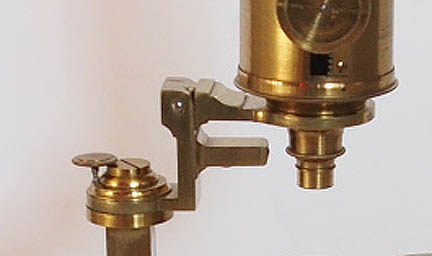 As shown to the left, at the top of the pillar is a swivelling joint which allows 360° rotation of the arm. The S-shaped arm has two fittings. At the top is a hinged support with a ring at its end, into which screws the compound body tube. The hinge allows the compound body-tube to be set vertical or horizontal. A small steel pin topped by a round knurled brass cap fits into a recess which locates the correct position for the compound body tube to be lined up with the optical axis of the stage and mirror.
As shown to the left, at the top of the pillar is a swivelling joint which allows 360° rotation of the arm. The S-shaped arm has two fittings. At the top is a hinged support with a ring at its end, into which screws the compound body tube. The hinge allows the compound body-tube to be set vertical or horizontal. A small steel pin topped by a round knurled brass cap fits into a recess which locates the correct position for the compound body tube to be lined up with the optical axis of the stage and mirror.
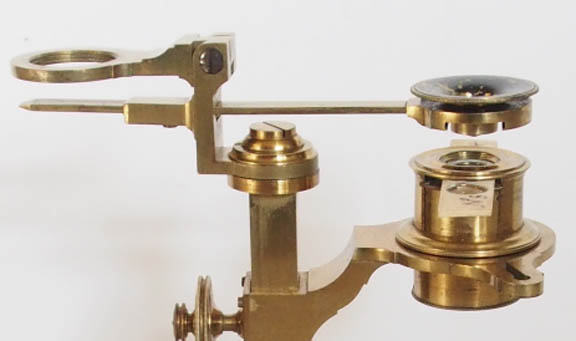 In the vertical part of the arm is a horizontally oriented rectangular tube which takes the sliding bar for the simple microscope. Inside this rectangular brass tube is a piece of pliable curved metal which, pressing against the bar, serves to keep the bar firmly seated, yet allows it to be adjusted forward or backward. This part of the microscope, set up for use as simple microscope, is shown to the right.
In the vertical part of the arm is a horizontally oriented rectangular tube which takes the sliding bar for the simple microscope. Inside this rectangular brass tube is a piece of pliable curved metal which, pressing against the bar, serves to keep the bar firmly seated, yet allows it to be adjusted forward or backward. This part of the microscope, set up for use as simple microscope, is shown to the right.
The height of the pillar measures 210 mm. The body tube can be extended by means of a rack and pinion from a total length of 117 to 175 mm. The body tube contains 3 bi-convex lenses, two at the eye, and one field lens. On this particular “numbered universal” microscope, there is no “between lens” immediately above the objective, as is present in other extant examples of this model. When in use, the microscope is 365 mm high with the body tube fully extended.
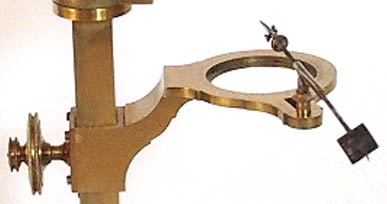
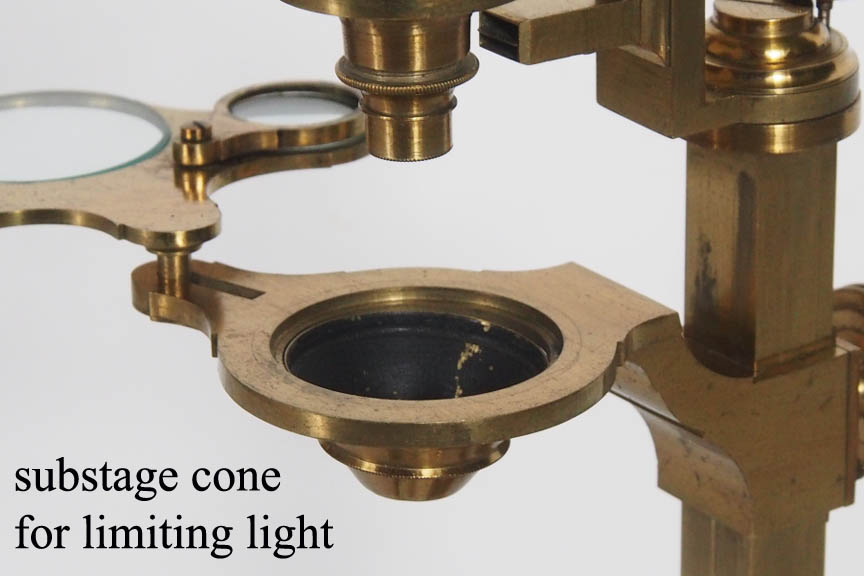 The circular stage(left) has one wing for accessories, and below is a tubular socket for insertion of a light-limiting brass cone(right).
The circular stage(left) has one wing for accessories, and below is a tubular socket for insertion of a light-limiting brass cone(right).
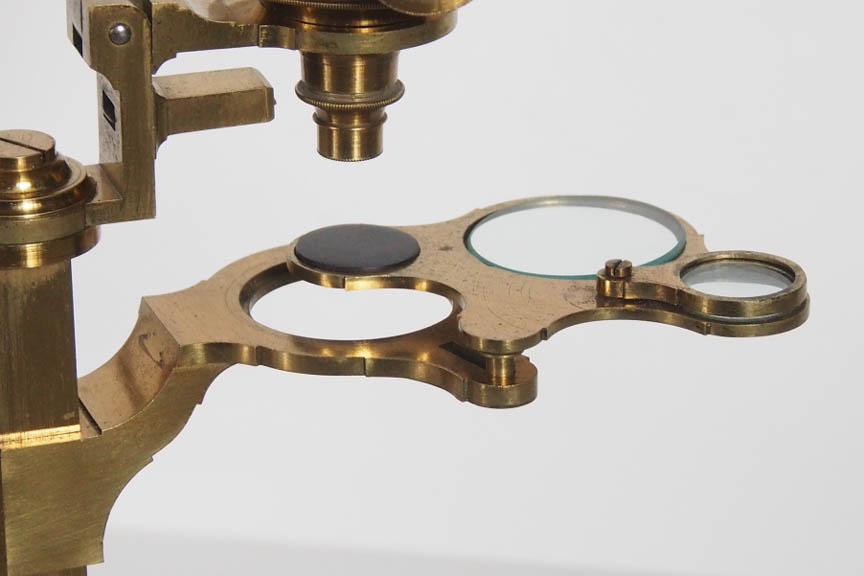 As shown to the left,an accessory stage can be inserted in the hole on the wing of the main stage. This accessory has three openings. The center one houses a large glass plate, and is suitable for dissecting. To each side of the larger open is a smaller opening. One of these holds a black and white disk for studying opaque specimens. The other is a wet cell which has a concave glass disk with a swiveling cover that can be brought over it to contain a liquid specimen. As this 3-disk accessory is rotated, each of the three portions pass into the center of the optical axis of the microscope.
As shown to the left,an accessory stage can be inserted in the hole on the wing of the main stage. This accessory has three openings. The center one houses a large glass plate, and is suitable for dissecting. To each side of the larger open is a smaller opening. One of these holds a black and white disk for studying opaque specimens. The other is a wet cell which has a concave glass disk with a swiveling cover that can be brought over it to contain a liquid specimen. As this 3-disk accessory is rotated, each of the three portions pass into the center of the optical axis of the microscope.
Five of the original six numbered objectives are for use with the compound body (No’s 1, 3, 4, 5, and 6); No 2 is missing). When used as a simple microscope, the body-tube is removed, and a bar is inserted into the sprung slot at the top of the pillar. Into the end of this any one of the three simple lenses with eye cups can be screwed, or a dovetailed slider with 6 lenses may be inserted, which can also be used with the solar microscope.
The solar microscope is in the usual three sections, the plate and mirror housing, the first part of the barrel with a condenser lens, the final focusing barrel with sprung specimen slot, rack work focusing, and a dovetail recess for the slider with 6 lenses.
The accessories with this set include:
- 5 numbered objectives
- 1 objective with silvered Lieberkuhn reflector
- Brass under stage cone to act as a light stop
- Circular brass live box
- Bonanni-type cylindrical spring stage for bone sliders
- Fish skin covered box with 8 numbered bone sliders with specimens
- 'Talc Box' for mica coverslips and brass circlips
- Stage forceps which fits into the wing of the main stage
- Fish plate with original green silk ribbon
- Three-aperture swivel stage with flat glass disc, small wet cell, and ebony disc
- Spare concave glass disc for above
- Small brass hand forceps
- Wet slider with 4 cells (period replacement)
- Brass slider with 6 single lenses of varying focus (replica made by the owner)
- Low power lens with black eye cup for use as simple microscope
- 2 high-powered lenses numbered “1” and “2” with black painted eye cups for use with the simple microscope
- Sliding arm for use with the simple microscope
- 3 large wooden sliders with specimens for use with the solar microscope
When purchased, there was no case, the compendium contained in a modified cutlery canteen. A replica case measuring 378 x 300 x 85 mm was made from pine, which was covered in tanned shark skin (import of untreated skin of lesser thickness being prohibited). To exactly match the 18th century appearance, the edges were lacquered red, a period lock and key were fitted, as well as the correct external brass hinges. Also hand-made is a brass escutcheon, and top plate for the handle to the design as used by Benjamin Martin on other compendia. The internal fittings of the case were made in light weight bass-wood covered with red cotton velvet. The inside of the lid is padded and is also covered by red cotton velvet.
HISTORY OF THE MICROSCOPES OF BENJAMIN MARTIN
Benjamin Martin(1704-1784) was an important maker of scientific instruments in the 18th century. Although what we now call the 'Martin Drum' microscope may have been invented by the Germans in the first years of the 18th century, it was Martin who refined and popularized them starting about 1730. At the same time, he worked on other designs, and as time went on offered several different designs. His 'Universal' microscope, part of the compendium shown on this page, underwent several iterations over the years and an earlier example of it can be seen on the Martin Universal page which also gives the history of the evolution of the Martin Universal Microscope. Occasionally Martin sold compendia similar or the same as the one shown above on this page. Some contained additional components besides those included with the one seen above. These often included a 'megaloscope' for projecting low power images of objects with the solar microscope, and sometimes even telescopes. Martin was also a maker of much more sophisticated instruments both for microscopy and astronomy. His tellurians and orreries are particularly famous and sophisticated.
 This instrument is not in my collection and I am honored to host this web page, with content and images contributed by the owner. The compound microscope forming part of this compendium is signed on the extendable body tube:
This instrument is not in my collection and I am honored to host this web page, with content and images contributed by the owner. The compound microscope forming part of this compendium is signed on the extendable body tube:  As shown to the left, at the top of the pillar is a swivelling joint which allows 360° rotation of the arm. The S-shaped arm has two fittings. At the top is a hinged support with a ring at its end, into which screws the compound body tube. The hinge allows the compound body-tube to be set vertical or horizontal. A small steel pin topped by a round knurled brass cap fits into a recess which locates the correct position for the compound body tube to be lined up with the optical axis of the stage and mirror.
As shown to the left, at the top of the pillar is a swivelling joint which allows 360° rotation of the arm. The S-shaped arm has two fittings. At the top is a hinged support with a ring at its end, into which screws the compound body tube. The hinge allows the compound body-tube to be set vertical or horizontal. A small steel pin topped by a round knurled brass cap fits into a recess which locates the correct position for the compound body tube to be lined up with the optical axis of the stage and mirror. In the vertical part of the arm is a horizontally oriented rectangular tube which takes the sliding bar for the simple microscope. Inside this rectangular brass tube is a piece of pliable curved metal which, pressing against the bar, serves to keep the bar firmly seated, yet allows it to be adjusted forward or backward. This part of the microscope, set up for use as simple microscope, is shown to the right.
In the vertical part of the arm is a horizontally oriented rectangular tube which takes the sliding bar for the simple microscope. Inside this rectangular brass tube is a piece of pliable curved metal which, pressing against the bar, serves to keep the bar firmly seated, yet allows it to be adjusted forward or backward. This part of the microscope, set up for use as simple microscope, is shown to the right.
 The circular stage(left) has one wing for accessories, and below is a tubular socket for insertion of a light-limiting brass cone(right).
The circular stage(left) has one wing for accessories, and below is a tubular socket for insertion of a light-limiting brass cone(right). As shown to the left,an accessory stage can be inserted in the hole on the wing of the main stage. This accessory has three openings. The center one houses a large glass plate, and is suitable for dissecting. To each side of the larger open is a smaller opening. One of these holds a black and white disk for studying opaque specimens. The other is a wet cell which has a concave glass disk with a swiveling cover that can be brought over it to contain a liquid specimen. As this 3-disk accessory is rotated, each of the three portions pass into the center of the optical axis of the microscope.
As shown to the left,an accessory stage can be inserted in the hole on the wing of the main stage. This accessory has three openings. The center one houses a large glass plate, and is suitable for dissecting. To each side of the larger open is a smaller opening. One of these holds a black and white disk for studying opaque specimens. The other is a wet cell which has a concave glass disk with a swiveling cover that can be brought over it to contain a liquid specimen. As this 3-disk accessory is rotated, each of the three portions pass into the center of the optical axis of the microscope.